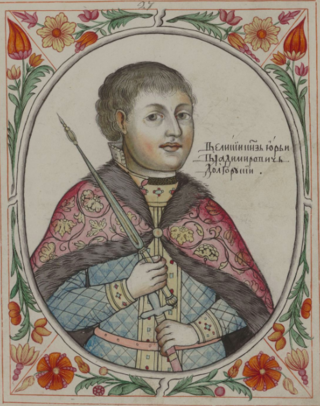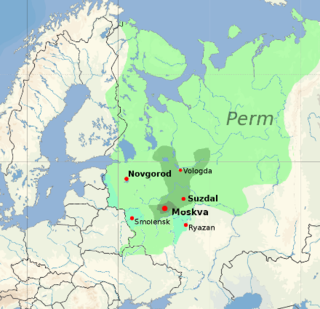
Yuri I Vladimirovich, commonly known as Yuri Dolgorukiy or the Long Arm, was a Monomakhovichi prince of Rostov and Suzdal, acquiring the name Suzdalia during his reign. Noted for successfully curbing the privileges of the landowning boyar class in Rostov-Suzdal and his ambitious building programme, Yuri transformed this principality into the independent power that would evolve into early modern Muscovy. Yuri Dolgorukiy was the founder of the Yurievichi dynasty, a branch of the Monomakhovichi.
Oleg Svyatoslavich ; c. 1052 – 1 August 1115) was a Rus Sviatoslavichi prince whose equivocal adventures ignited political unrest in Kievan Rus' at the turn of the 11th and 12th centuries. He reigned as Prince of Chernigov from 1097 to 1115, and was the progenitor of the Olgovichi family.
Severia or Siveria is a historical region in present-day southwest Russia, northern Ukraine, and eastern Belarus. The largest part lies in modern Russia, while the central part of the region is the city of Chernihiv in Ukraine.

Mstislav Mstislavich the Daring, also called the Able, was a prince of Tmutarakan and Chernigov, one of the princes from Kievan Rus' in the decades preceding the Mongol invasions.

Igor Svyatoslavich, nicknamed the Brave, was Prince of Novgorod-Seversk (1180–1198) and Prince of Chernigov (1198–1201/1202).

The Principality of Chernigov was one of the largest and most powerful states within Kievan Rus'. For a time the principality was the second most powerful after Kiev. The principality was formed in the 10th century and maintained some of its distinctiveness until the 16th century. The Principality of Chernigov consisted of regions of modern-day Ukraine, Belarus, and Russia.

In Russian historiography the term Upper Oka Principalities traditionally applies to about a dozen tiny and ephemeral polities situated along the upper course of the Oka River at the turn of the 14th and 15th centuries. They were reigned by the "upper princes", each of which descended from Mikhail Vsevolodovich of Chernigov. Nowadays, the areas concerned lie within the bounds of the Tula Oblast, Kaluga Oblast, Oryol Oblast and Bryansk Oblast of the Russian Federation.
Prince of Novgorod-Seversk was the kniaz, the ruler or sub-ruler, of the Principality of Novgorod-Seversk. It may have been created in 1139, the date of one modern authority, and is most famous for Igor Sviatoslavich, hero of the Old East Slavic Tale of Igor's Campaign.
The Prince of Chernigov was the kniaz, the ruler or sub-ruler, of the Rus' Principality of Chernigov, a lordship which lasted four centuries straddling what are now parts of Ukraine, Belarus and the Russian Federation.

The Principality of Murom, also referred to as the Murom-Ryazan Principality until the mid-12th century, was a principality with its capital in Murom, now in Vladimir Oblast, Russia. Murom lay in an area that was strongly Finnic and for much of its medieval history, located in the homeland of the Muromians. In 1392, it was incorporated into the Grand Principality of Moscow.

The Council of Liubech was one of the best documented princely meetings in Kievan Rus' that took place in Liubech on October 19, 1097. The council ended the Chernihiv war of succession (1093–1097) between Sviatopolk II of Kiev, Vladimir II Monomakh and Oleg I of Chernigov who fought for the heritage of his father Sviatoslav II of Kiev.

The Principality of Moscow or Grand Duchy of Moscow, also known simply as Muscovy, was a principality of the Late Middle Ages centered on Moscow. It eventually evolved into the Tsardom of Russia in the early modern period. The princes of Moscow were descendants of the first prince Daniel, referred to in modern historiography as the Daniilovichi, a branch of the Rurikids.

Kievan Rus', also known as Kyivan Rus', was a state and later an amalgam of principalities in Eastern and Northern Europe from the late 9th to the mid-13th century. The name was coined by Russian historians in the 19th century. Encompassing a variety of polities and peoples, including East Slavic, Norse, and Finnic, it was ruled by the Rurik dynasty, founded by the Varangian prince Rurik. The modern nations of Belarus, Russia, and Ukraine all claim Kievan Rus' as their cultural ancestor, with Belarus and Russia deriving their names from it, and the name Kievan Rus' derived from what is now the capital of Ukraine. At its greatest extent in the mid-11th century, Kievan Rus' stretched from the White Sea in the north to the Black Sea in the south and from the headwaters of the Vistula in the west to the Taman Peninsula in the east, uniting the East Slavic tribes.
Mstislav II Svyatoslavich was a Kievan Rus' prince. His baptismal name was Panteleymon. He was probably prince of Kozelsk (1194–1223), of Novgorod-Seversk (1206–1219), and of Chernigov (1215/1220–1223). He was killed in the Battle of the Kalka River.
Oleg III Svyatoslavich was a Kievan Rus' prince. His baptismal name was Feodosy. He was prince of Vshchizh, of Novgorod-Seversk (1200–1201), and of Chernigov (1201/1202–1204).
Vladimir III Svyatoslavich was an Olgovichi prince. His baptismal name was Boris. He was prince of Gomiy (1164–?), of Novgorod, of Karachev (1194–?), and probably of Novgorod-Seversk (1198–1200).

The Principality of Tver was a principality which existed between the 13th and the 15th centuries with its capital in Tver. It was one of the states established after the decay of the Kievan Rus'. During the 14th century, Tver rivaled the Principality of Moscow with the aim to become the center of the united Russian state. Eventually it lost, decayed, and in 1485, it was annexed by Moscow. The principality was located approximately in the area currently occupied by Tver Oblast and the eastern part of Smolensk Oblast in Russia.
Könchek was a Polovtsian khan of the 12th century.











